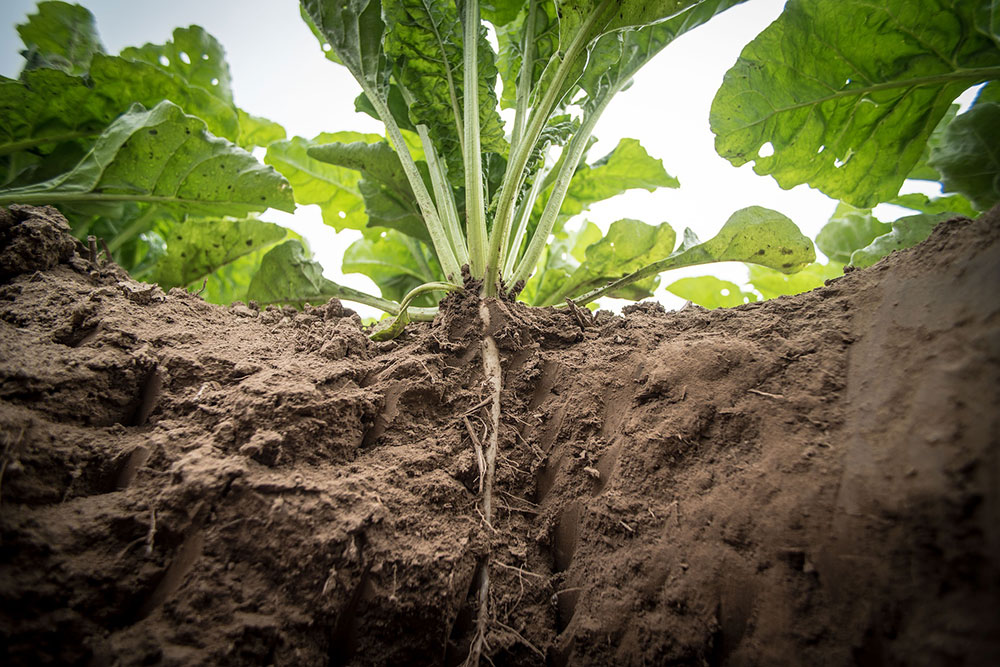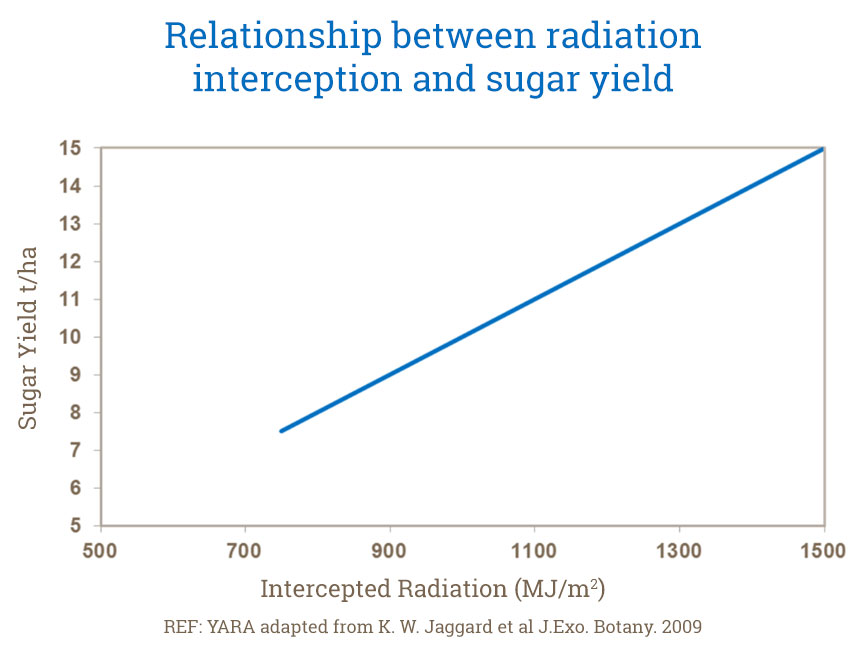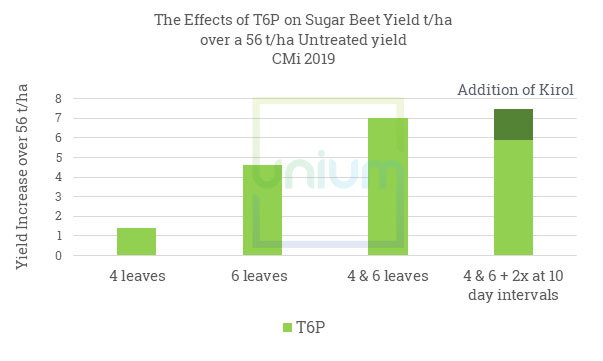
OVERVIEW
“Feed before you Weed”
2, 4 and 6 leaf stages are the critical timings for biostimulation and nutritional support.
Calcium Phosphite (aCalsa / Calfite) at the 2-4 leaf stage
T6P at the 4 & 6 leaf stage
Kirol provides a programmed approach to ongoing stress reduction as a partner to the other products.
The return from a sugar beet crop is based upon beet weight and the % sugar content of the beet to give a sugar yield per hectare. Simple, or is it? Many things can impact on one or the other, or both.
How do we maximise the yield of sugar beet? It is a very clear relationship between sunlight interception and yield, as can be seen below. This can be achieved agronomically in several ways; more leaves, more quickly, larger leaves, more dense chlorophyll within the leaves, and then ultimately the efficiency of the photosynthesis within the leaf to make use of the light.
So, the key is to maximise green leaf area as soon as possible, boost chlorophyll content and maintain this for as long as possible through the season.
A combination of the correct nutrition and their interaction with specific biostimulants can help to achieve this. But one of the key areas to consider is how to mitigate against the effects of herbicides on crop growth.
Crop nutrition has to be optimal to withstand the effects of herbicides. That’s one of the findings of a project looking at the connection between herbicides of the sulfonyl urea group and nutrient deficiencies in barley. Project leader Ian Black of Northfield Research Laboratories says the “take home message” is that given adequate nutrition, crops will recover to normal levels after the early setbacks caused by the herbicides.
The herbicides can reduce growth immediately after application and sometimes reduce grain yield, particularly where barley (and wheat) have been sown on sandy slopes low in organic matter.
Researchers on this project funded by growers through the GRDC also found a reduction in root length following application of the herbicides, and believe this could be responsible for the reduction in plant nutrition.
GRDC 1993
The processing of the herbicide by the beet takes precious reserves within the plant and can limit uptake from the soil, which if in short supply can cause “hidden hunger” and overall crop stress.
In wheats it has been shown there are different varietal tolerances to herbicides e.g. SU’s and their impact on nutrient assimilation – some varieties show no effect and others it considerably reduces nitrogen utilisation. Maybe the same is true for sugar beet?
Early in the season, nitrogen is one of the key components to promote growth and interacts with potassium, phosphorus etc, as well as trace minerals. With this in mind, the old adage “feed before you weed” comes to mind and we should always ensure crops are nutritionally optimal before applying herbicides. Some of this stress has been shown to be mitigated in several crops by application of biostimulants e.g. aCalsa, Calfite, and Kirol. These should be applied either before or with the herbicide.
Stabilised Calcium phosphite is the safest phosphite formulation as it is stabilised to reduce reactivity, buffered to ensure no pH phytotoxicity and also has a very low salt index (not sodium) unlike any other phosphite – which again reduces the stress on the crop.
This is perfect for the early application to very young tender plants to promote the early root growth, root activation and nutrient assimilation. Phosphorus and potassium uptake will be maximised, especially under compromised soil conditions.
Foliar K can be applied using Wholly K which provides no negative antagonistic anions along with PGA.
Last years CMi data clearly showed the key timing to be 4 and 6 leaves for the optimal application of a biostimulant, with no added benefit from two additional applications at 10-14 day intervals.
T6P, as we described in our last bulletin, is all about managing drought stress and optimising sugar allocation, so it is the perfect partner for the sugar beet crop, as the trials show.
When Kirol was applied as well as T6P at programmed timings, it resulted in a yield increase of 1.6 t/ha to give a maximum response of 7.75 t/ha in the trial. It wasn’t trialled at the earlier timings of 4 and 6 leaves.
Amino acids play a supporting role to the key biostimulants aCalsa, Calfite, T6P and should be added to the programme for maximum benefit. As timing is so critical for amino acids, a programmed approach has to be taken. Kirol provides an affordable programme to capitalise on these benefits while ensuring a return.
With growth stages variable and abiotic stress currently consistent, look to mitigate its effects rather than add to it when you make applications.
- Ensure your nutrients are bioavailable – they may be in the soil but, under current conditions, their availability may be limited, e.g. P, K, Ca, B etc. Check with tissue/sap testing for a more accurate picture.
- Consider an early application of calcium phosphite to overcome establishment stresses and maximise root growth and activation
- Apply T6P with Kirol at 4 and 6 leaves for maximum benefit
- Ongoing stress can be mitigated with Kirol.
The major factors that influence yield and sugar content – temperature, light intensity and water – are challenges we may not have control over (irrigation will help re water availability), but we can prime the crop to utilise what’s available to the maximum. With the best response to biostimulant and nutrition between 2 – 8 leaves, it’s imperative to ensure sufficiency to optimise the crop’s potential.



